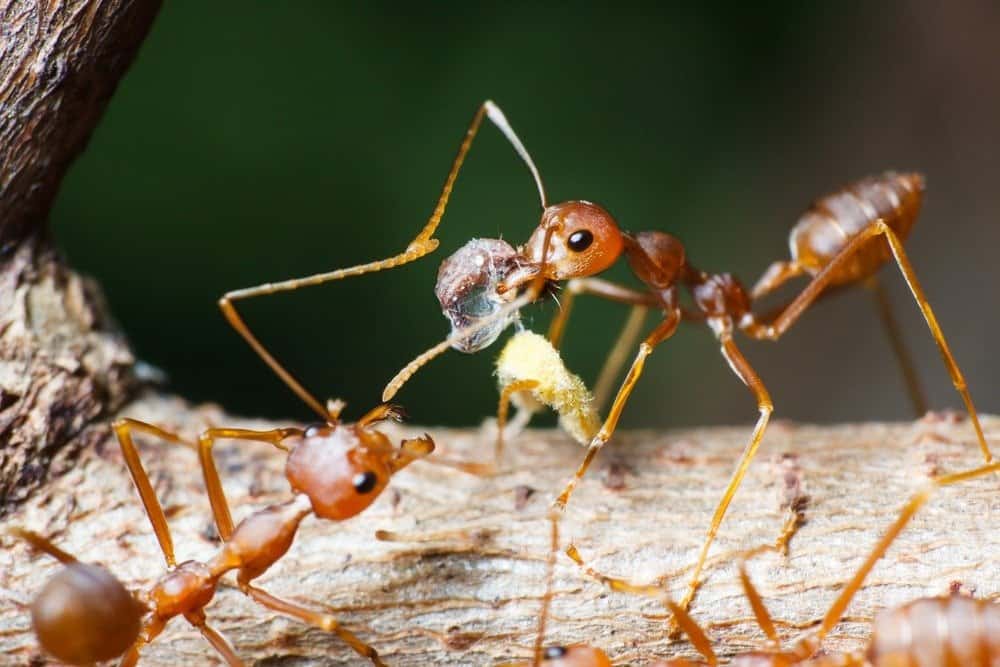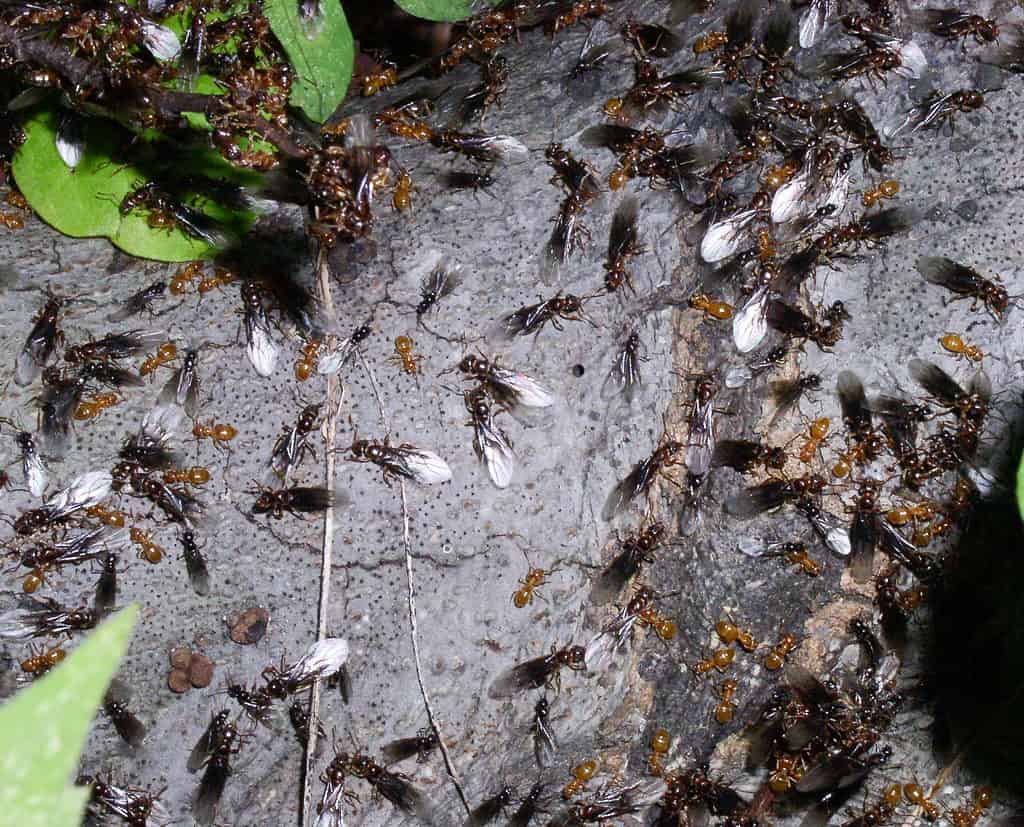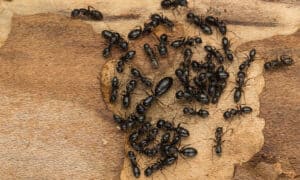Did you know that the United States is home to a remarkable 1,000 known ant species out of the 12,000 found worldwide? That’s right! These tiny yet remarkable creatures have made their homes nationwide, showcasing their remarkable diversity.
In this article, we will unveil the top 10 largest ants crawling around the U.S., each with its captivating traits and fascinating behaviors.
1: Carpenter Ant (Camponotus) – up to 1 inch
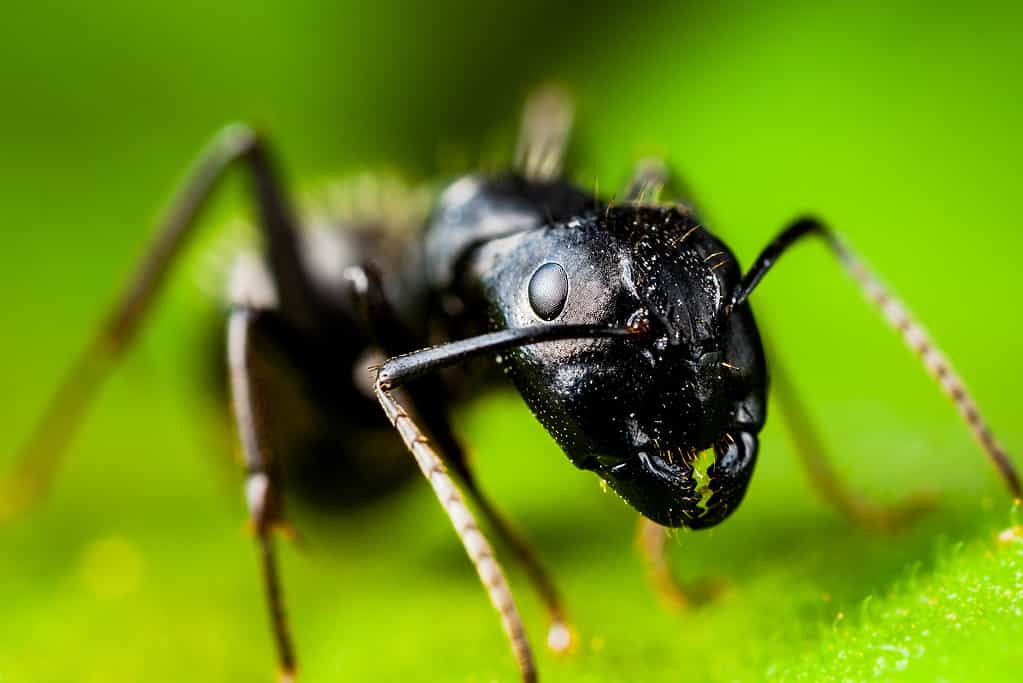
These impressive insects can grow up to an astonishing 1 inch in length!
©Denis Vesely/Shutterstock.com
Carpenter ants are not only the largest ant species in the United States but also in North America. These ants are native to forested areas worldwide. These impressive insects can grow up to an astonishing 1 inch in length!
Carpenter ants are known for their dark-colored bodies, slim waists, antennae that bend like elbows, and shorter hind wings compared to their front wings (if they have wings).
While they typically make their nests in decaying wood, they pose a significant threat to buildings and structures by infesting moisture-weakened materials, such as houses, sheds, and lumber piles.
These carpenter ants have a hearty appetite and are enthusiastic eaters. They consume proteins and sugar, which can be found in various sources such as living and dead insects, honeydew, meats, pet food, syrup, and honey. Interestingly, despite their name, carpenter ants do not consume wood.
During warm and humid conditions, carpenter ants engage in a captivating phenomenon known as nuptial flight. Winged males and females emerge from their satellite nests, taking to the skies in search of mates. In this mesmerizing display, females mate with multiple males while airborne, while the males sadly perish after fulfilling their reproductive duties.
2: Texas Leafcutter Ant (Atta texana) – up to 0.75 inches
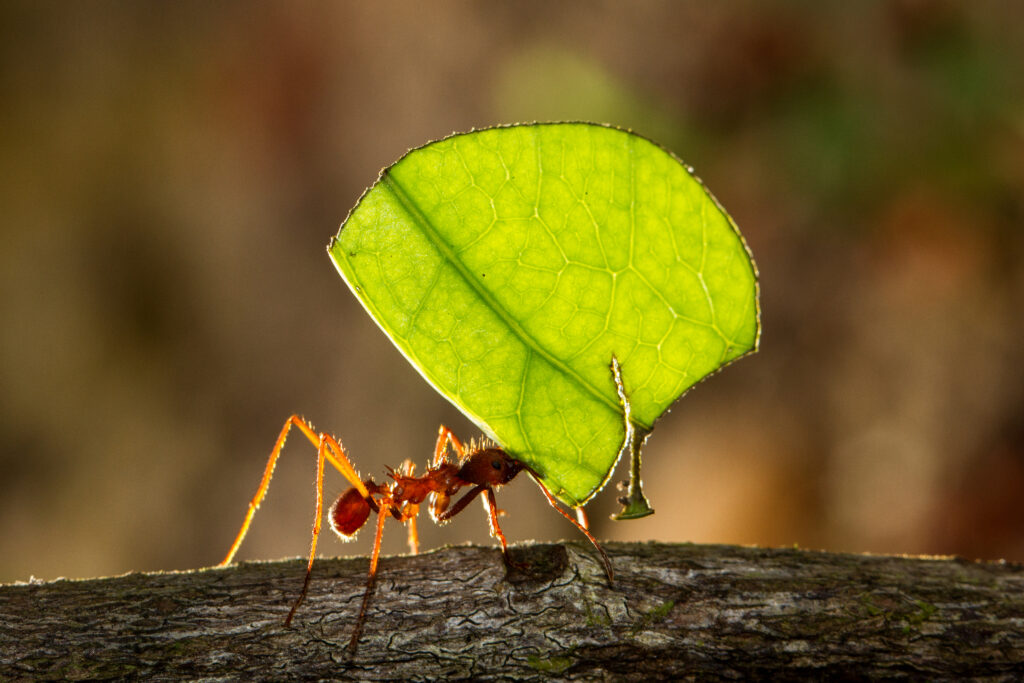
Leafcutter ant carrying a leaf to its nest.
©Ken Griffiths/Shutterstock.com
The Texas leafcutter ant, native to Texas and found as far as Louisiana, holds the title of the second-largest ant species in the United States. These remarkable ants can reach a length of up to 0.75 inches. Their color ranges from rust to dark brown, and interestingly, workers within the same colony display significant variations in size.
Living in vast colonies that can reach a staggering two million individuals, leafcutters have earned their name due to their unique habit of cutting leaves and other plant parts from a wide range of vegetation. They establish their colonies in various habitats, such as roadsides, open fields, forests, and brushlands, with a preference for deep sandy or loamy soils.
Unlike many other ant species, leaf-cutting ants have a particular dietary preference. They solely consume the fungus they cultivate, which makes them unresponsive to most conventional ant baits, including those based on sugar or oil.
Furthermore, the ants possess a formidable bite, which the soldier ants employ to defend their colony against invasive predators.
3: Red Harvester Ant (Pogonomyrmex barbatus) – up to 0.5 inches

©Kessler Bowman/Shutterstock.com
The red harvester ant holds the third spot among the largest ants found in the United States. However, their population has significantly declined compared to the early 1900s. These ants can grow up to 0.5 inches in length.
Red harvester ant workers exhibit a distinct appearance, ranging in color from red to dark brown. They possess elbowed antennae, square heads, and large mandibles on their bodies. Their nests or mounds are easily recognizable.
While certain species of harvester ants thrive in wooded areas, the red harvester ant prefers open grasslands, particularly those with clay loam soils. Red harvester ants are most active during dry conditions and hot weather.
The primary dietary preference of red harvester ants consists of seeds, which they gather and store in large quantities. They are skilled hoarders.
Although red harvester ant workers are capable of inflicting painful, stinging bites, they generally exhibit reluctance to attack. The effects of their bites can extend through lymph channels and potentially pose medical risks. It’s worth noting that worker ants are commonly sold for ant farms.
4: Allegheny Mound Ant (Formica exsectoides) – up to 0.5 inches
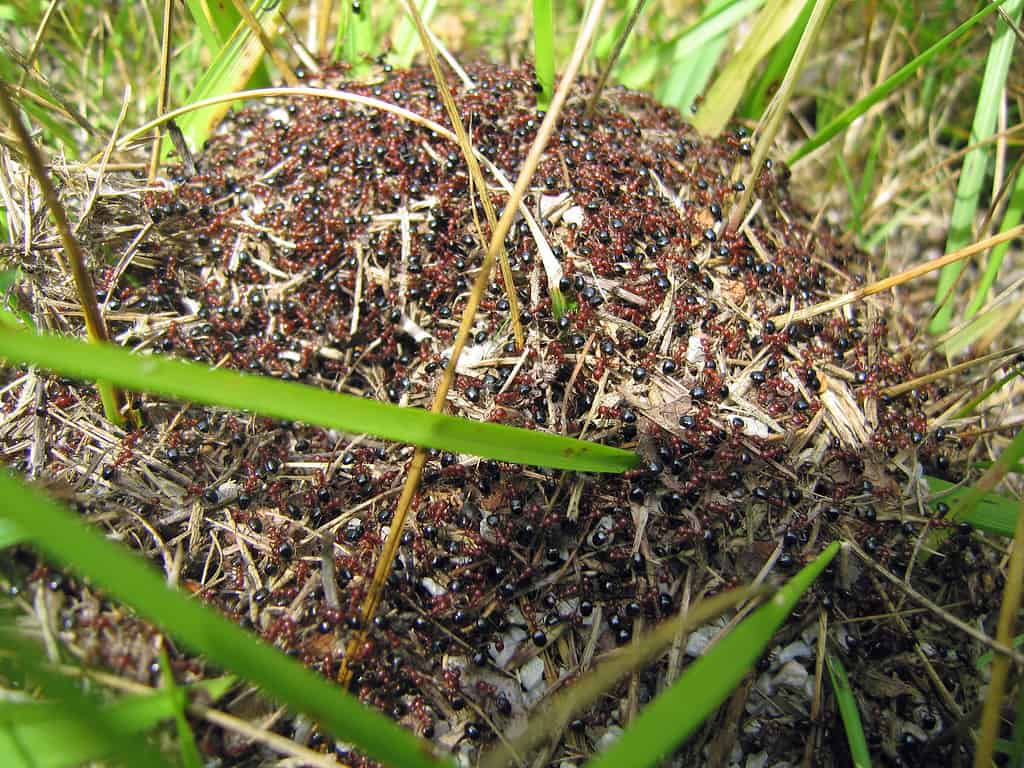
The colonies of Allegheny mound ants are incredibly complex.
©Allegheny Mound Ants, Formica exsectoides – Original / License
The Allegheny mound ant, positioned comfortably at the 4th spot, is half an inch in size. These ants are native to the eastern regions of North America, spanning from Nova Scotia to Georgia.
Sporting a reddish head and thorax, with dark brown to black abdomens and legs, they create distinctive mounds common in wild blueberry fields, open forests, and old-field habitats.
The Allegheny mound ant feeds on a diet of insects and honeydew, a sugary substance secreted by sap-feeding insects such as aphids or scales.
Their most striking feature is the construction of large mounds, which are the result of their excavation work. These mounds are composed of soil brought up from their deep burrows and chambers. Even at just 5 months old, a mound can reach a width of approximately 2 feet and a height of 8 inches. Over two years, these mounds can grow as tall as 3 feet.
While the mounds serve as remarkable architectural achievements, the Allegheny mound ants can also become pests in certain environments.
5: Army Ant (Dorylinae) – up to 0.5 inches
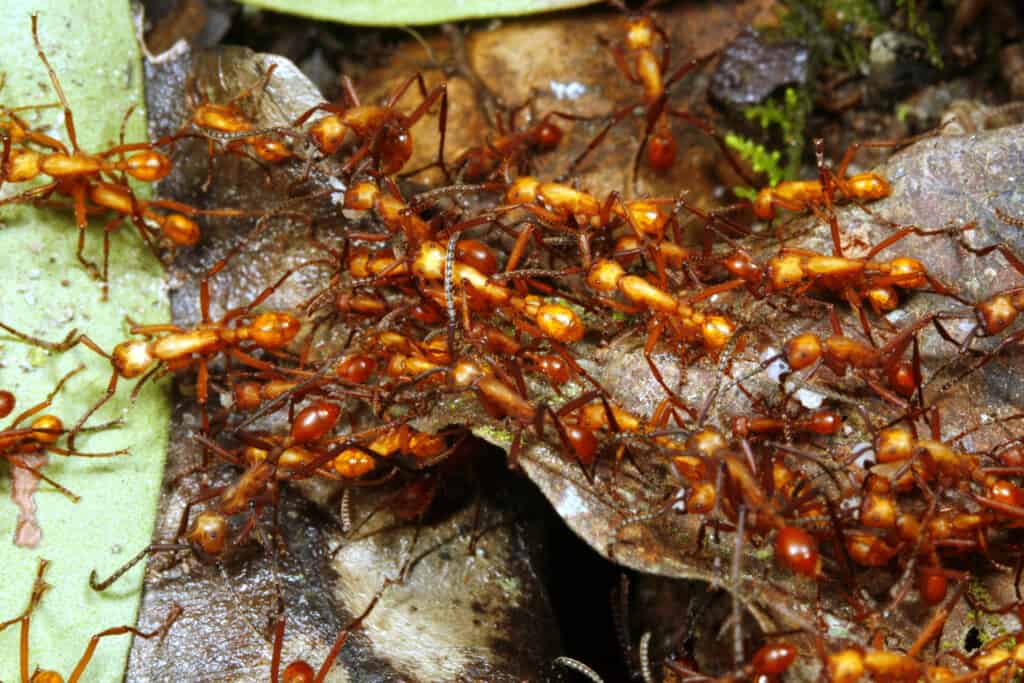
With their oval-shaped abdomens, the army ants possess a potent stinger located in this particular segment of their bodies.
©Dr Morley Read/Shutterstock.com
The army ant, a fascinating creature measuring around 0.5 inches in length, encompasses a diverse group of over 200 ant species. What sets them apart is their remarkable ability to conduct aggressive predatory foraging expeditions, known as “raids,” during which a massive number of ants swarm and search for food within a limited area.
With their oval-shaped abdomens, the army ants possess a potent stinger located in this particular segment of their bodies. Interestingly, they utilize their antennae not only for detecting smells but also for tactile exploration.
While army ants are typically found in humid climates, they are known to venture into agricultural landscapes and dense forests in search of sustenance. Unlike most ant species, army ants do not construct permanent nests; instead, they are in a constant state of movement, perpetually migrating throughout their existence.
Most army ants have specialized diets that primarily consist of preying on other ant species.
Although the army ant species in the United States can grow up to half an inch long, it’s important to note that specific sub-species of these ants claim the impressive title of being the largest ants on our planet. Additionally, African Dorylus queens possess an astonishing reproductive potential, capable of laying several million eggs per month, making them the most prolific egg-layers among all insects.
6: Florida Harvester Ant (Pogonomyrmex badius) – up to 0.37 inches
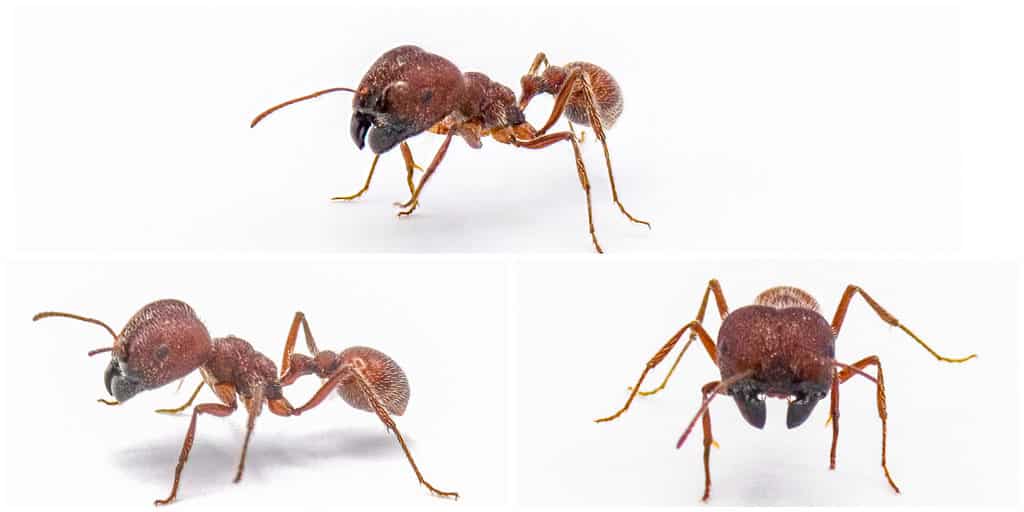
The Florida harvester ant is a species in the Pogonomyrmex genus.
©iStock.com/Dan Rieck
Meet the Florida harvester ant, a fascinating species found in the United States, stretching from Florida up to North Carolina. It ranks as the sixth largest ant in the country, measuring an impressive 0.37 inches in length.
As adults, they boast a dark rust-red coloration. Among the worker caste, there is a noticeable polymorphism, meaning that individuals within the same group can have strikingly different appearances. Notably, the significant workers possess disproportionately enlarged heads, adding to their unique profile.
When it comes to their choice of habitat, the Florida harvester ant has a strong preference for nesting in sandy areas. They require open spaces to construct their nests, often favoring open woodlands or grassy regions. You can commonly find their nests on lawns, around gardens, and even in fire lanes.
While their diet primarily consists of seeds, these resourceful ants exhibit a more versatile palate. They also consume crop pests, termites, screwworm larvae, and even cattle ear ticks, demonstrating their ability to adapt and exploit available food sources.
Impressively, the Florida harvester ant remains highly active even in relatively low humidity levels, specifically below 55 percent, and thrives in high temperatures.
7: Western Thatching Ant (Formica obscuripes) – up to 0.31 inches
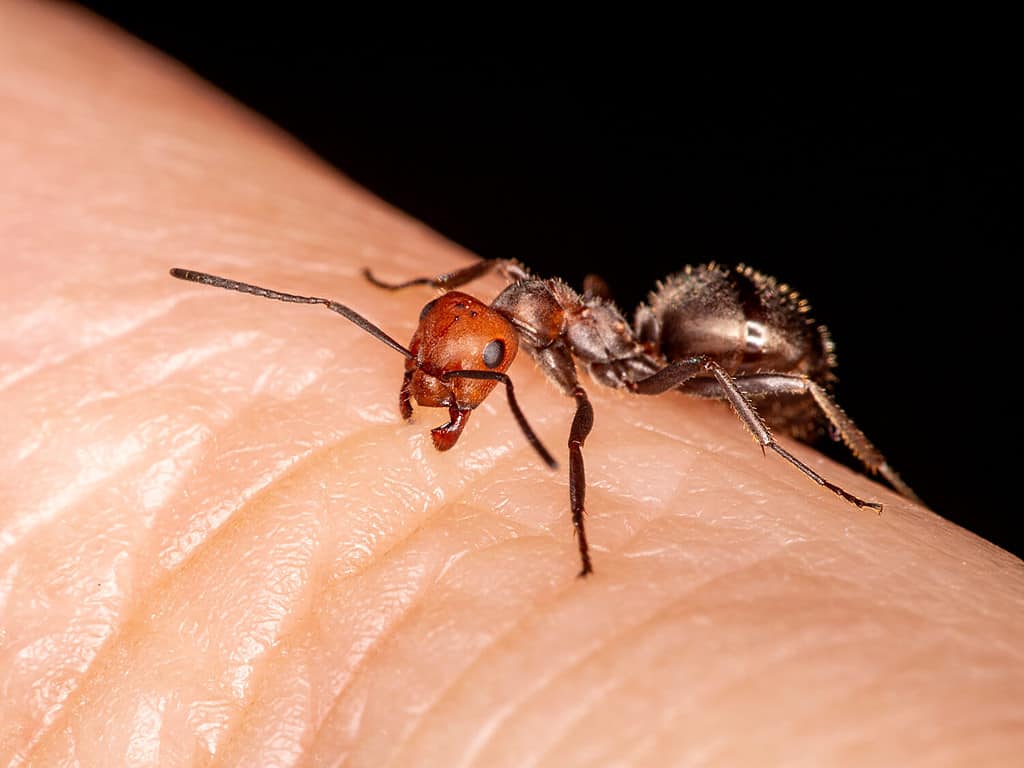
This species dominates various ecosystems, with its large thatched mounds and colossal colonies housing tens or even hundreds of thousands.
©Ernie Cooper/Shutterstock.com
The Western thatching ant, a native species of North America, is a fascinating insect known for its unique characteristics. Measuring 0.31 inches in length, it proudly holds the seventh position in terms of size among its ant counterparts in the United States.
Most of these ants display a captivating bicolored appearance, with a striking combination of red and black. However, a minority group stands out with their sleek, all-black coloration. When observed from the side, this medium to large ants exhibits a distinct notch or depression on the top of their thorax.
This species dominates various ecosystems, with its large thatched mounds and colossal colonies housing tens or even hundreds of thousands of diligent workers. The sight of these mounds covered in small pieces of plant material leaves no doubt about the identity of these remarkable ants.
Their diet is diverse, as they are omnivores with a taste for many kinds of insects, such as grasshoppers, beetles, pillbugs, and even other ant species. Additionally, they scavenge on deceased insects and savor the sweet nectar of plants, as well as leaves, galls, and flowers.
These ants serve as prey for numerous insect and bird species while also preying on a wide array of other insects, effectively maintaining a balance in their environment.
8: Velvety Tree Ant (Liometopum occidentale) – up to 0.25 inches
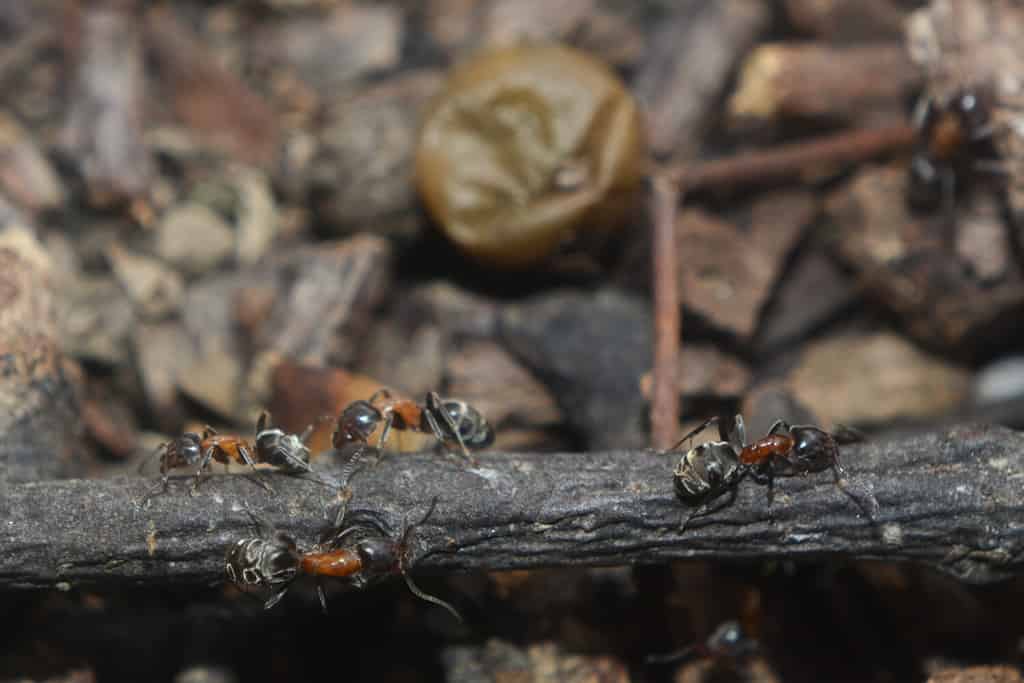
©Vincent Grebenicek/Shutterstock.com
Velvety tree ants are a fascinating species known for causing trouble to many. Measuring up to 0.25 inches in length, they rank as the eighth largest ant species in the United States.
With their velvety black abdomens, dark heads, and reddish thorax, these ants possess a distinctive appearance. Both male and female reproductives of the species have wings.
These ants typically establish their nests in the crooks and hollows of trees or beneath stones within their natural habitat.
In the wild, velvety tree ants primarily survive outdoors, thriving on the honeydew produced by aphids, mealybugs, and scales that infest various plants, trees, and shrubs.
Caution is advised when dealing with velvety tree ants, as they are considered to be dangerous. They exhibit aggressive behavior and will bite anyone or anything they perceive as a threat. What makes their bite particularly excruciating is the fact that they release secretions into the wound.
9: Citronella Ant (Acanthomyops) – up to 0.25 inches
The citronella ant is a fascinating species known for its distinctive lemon or citronella odor when crushed. These ants have a glossy brick-red or brownish-red color and can reach a size of up to 0.25 inches. They possess a single-segmented waist and lack a stinger.
When it comes to their nesting habits, citronella ants prefer to make their homes in the soil. Outdoors, they can be found nesting under logs, rocks, landscape timbers, and even beside foundations. Interestingly, these ants have no interest in human food and primarily feed on aphid honeydew.
Citronella ants are diurnal creatures, meaning they are active during the day. You can often spot them in gardens, parks, and various outdoor areas.
Despite their small size, they are known for their aggressive behavior and will not hesitate to attack humans or animals if they feel threatened.
10: Red Imported Fire Ant (Solenopsis invicta) – up to 0.25 inches

When it comes to their diet, red imported fire ants are known to feed on the buds and fruits of various crops.
©NOTE OMG/Shutterstock.com
Red imported fire ants are last on the list but certainly not the smallest, with a length of 0.25 inches. Sporting a dark reddish-brown coloration, they possess two nodes on the petiole and a two-segmented antennal club.
They can be found in diverse environments such as rainforests, disturbed areas, deserts, grasslands, near roads and buildings, and even inside electrical equipment.
When it comes to their diet, red imported fire ants are known to feed on the buds and fruits of various crops, with a particular preference for crops like corn, soybean, okra, and citrus.
An interesting behavior exhibited by these invasive pests is their tendency to bury food during the foraging process. Unfortunately, the factors influencing this behavior and the observable patterns it follows remain largely unknown.
Summary Of The 10 Largest Ants Crawling Around The U.S.
| Rank | Name | Size |
| 1 | Carpenter Ant | 1 inch |
| 2 | Texas Leafcutter Ant | 0.75 inches |
| 3 | Red Harvester Ant | 0.5 inches |
| 4 | Allegheny Mount Ant | 0.5 inches |
| 5 | Army Ant | 0.5 inches |
| 6 | Florida Harvester Ant | 0.37 inches |
| 7 | Western Thatching Ant | 0.31 inches |
| 8 | Velvety Tree Ant | 0.25 inches |
| 9 | Citronella Ant | 0.25 inches |
| 10 | Red Imported Fire Ant | 0.25 inches |
Thank you for reading! Have some feedback for us? Contact the AZ Animals editorial team.

